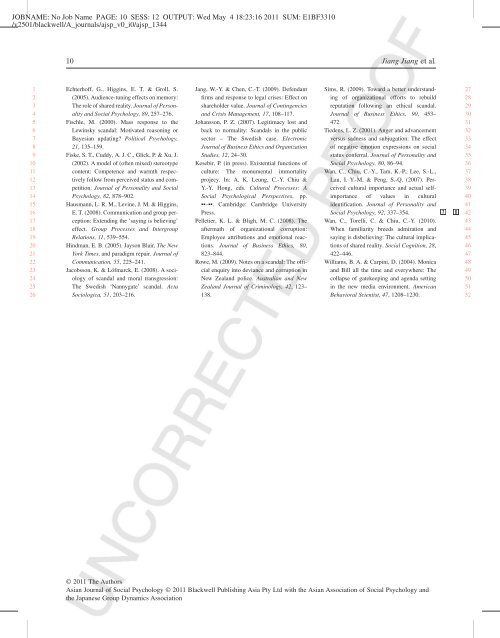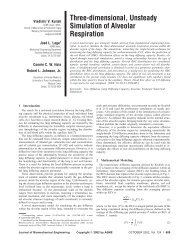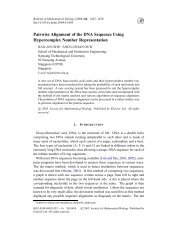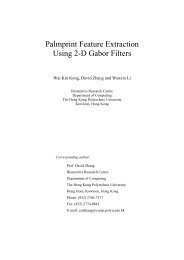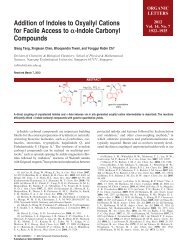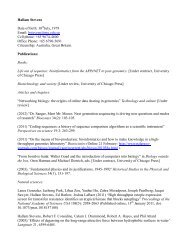Emotional reactions to scandals: When does moral character make ...
Emotional reactions to scandals: When does moral character make ...
Emotional reactions to scandals: When does moral character make ...
You also want an ePaper? Increase the reach of your titles
YUMPU automatically turns print PDFs into web optimized ePapers that Google loves.
JOBNAME: No Job Name PAGE: 10 SESS: 12 OUTPUT: Wed May 4 18:23:16 2011 SUM: E1BF3310<br />
/v2501/blackwell/A_journals/ajsp_v0_i0/ajsp_1344<br />
1<br />
2<br />
3<br />
4<br />
5<br />
6<br />
7<br />
8<br />
9<br />
10<br />
11<br />
12<br />
13<br />
14<br />
15<br />
16<br />
17<br />
18<br />
19<br />
20<br />
21<br />
22<br />
23<br />
24<br />
25<br />
26<br />
10 Jiang Jiang et al.<br />
Echterhoff, G., Higgins, E. T. & Groll, S.<br />
(2005). Audience-tuning effects on memory:<br />
The role of shared reality. Journal of Personality<br />
and Social Psychology, 89, 257–276.<br />
Fischle, M. (2000). Mass response <strong>to</strong> the<br />
Lewinsky scandal: Motivated reasoning or<br />
Bayesian updating? Political Psychology,<br />
21, 135–159.<br />
Fiske, S. T., Cuddy, A. J. C., Glick, P. & Xu, J.<br />
(2002). A model of (often mixed) stereotype<br />
content: Competence and warmth respectively<br />
follow from perceived status and competition.<br />
Journal of Personality and Social<br />
Psychology, 82, 878–902.<br />
Hausmann, L. R. M., Levine, J. M. & Higgins,<br />
E. T. (2008). Communication and group perception:<br />
Extending the ‘saying is believing’<br />
effect. Group Processes and Intergroup<br />
Relations, 11, 539–554.<br />
Hindman, E. B. (2005). Jayson Blair, The New<br />
York Times, and paradigm repair. Journal of<br />
Communication, 55, 225–241.<br />
Jacobsson, K. & Löfmarck, E. (2008). A sociology<br />
of scandal and <strong>moral</strong> transgression:<br />
The Swedish ‘Nannygate’ scandal. Acta<br />
Sociologica, 51, 203–216.<br />
Jang, W.-Y. & Chen, C.-T. (2009). Defendant<br />
firms and response <strong>to</strong> legal crises: Effect on<br />
shareholder value. Journal of Contingencies<br />
and Crisis Management, 17, 108–117.<br />
Johansson, P. Z. (2007). Legitimacy lost and<br />
back <strong>to</strong> normality: Scandals in the public<br />
sec<strong>to</strong>r – The Swedish case. Electronic<br />
Journal of Business Ethics and Organization<br />
Studies, 12, 24–30.<br />
Kesebir, P. (in press). Existential functions of<br />
culture: The monumental immortality<br />
projecy. In: A. K. Leung, C.-Y. Chiu &<br />
Y.-Y. Hong, eds. Cultural Processes: A<br />
Social Psychological Perspectives, pp.<br />
– . Cambridge: Cambridge University<br />
Press.<br />
Pelletier, K. L. & Bligh, M. C. (2008). The<br />
aftermath of organizational corruption:<br />
Employee attributions and emotional <strong>reactions</strong>.<br />
Journal of Business Ethics, 80,<br />
823–844.<br />
Rowe, M. (2009). Notes on a scandal: The official<br />
enquiry in<strong>to</strong> deviance and corruption in<br />
New Zealand police. Australian and New<br />
Zealand Journal of Criminology, 42, 123–<br />
138.<br />
Sims, R. (2009). Toward a better understanding<br />
of organizational efforts <strong>to</strong> rebuild<br />
reputation following an ethical scandal.<br />
Journal of Business Ethics, 90, 453–<br />
472.<br />
Tiedens, L. Z. (2001). Anger and advancement<br />
versus sadness and subjugation: The effect<br />
of negative emotion expressions on social<br />
status conferral. Journal of Personality and<br />
Social Psychology, 80, 86–94.<br />
Wan, C., Chiu, C.-Y., Tam, K.-P., Lee, S.-L.,<br />
Lau, I. Y.-M. & Peng, S.-Q. (2007). Perceived<br />
cultural importance and actual selfimportance<br />
of values in cultural<br />
identification. Journal of Personality and<br />
Social Psychology, 92, 337–354.<br />
Wan, C., Torelli, C. & Chiu, C.-Y. (2010).<br />
<strong>When</strong> familiarity breeds admiration and<br />
saying is disbelieving: The cultural implications<br />
of shared reality. Social Cognition, 28,<br />
422–446.<br />
Williams, B. A. & Carpini, D. (2004). Monica<br />
and Bill all the time and everywhere: The<br />
collapse of gatekeeping and agenda setting<br />
in the new media environment. American<br />
Behavioral Scientist, 47, 1208–1230.<br />
© 2011 The Authors<br />
Asian Journal of Social Psychology © 2011 Blackwell Publishing Asia Pty Ltd with the Asian Association of Social Psychology and<br />
the Japanese Group Dynamics Association<br />
27<br />
28<br />
29<br />
30<br />
31<br />
32<br />
33<br />
34<br />
35<br />
36<br />
37<br />
38<br />
39<br />
40<br />
41<br />
42<br />
43<br />
44<br />
45<br />
46<br />
47<br />
48<br />
49<br />
50<br />
51<br />
52


